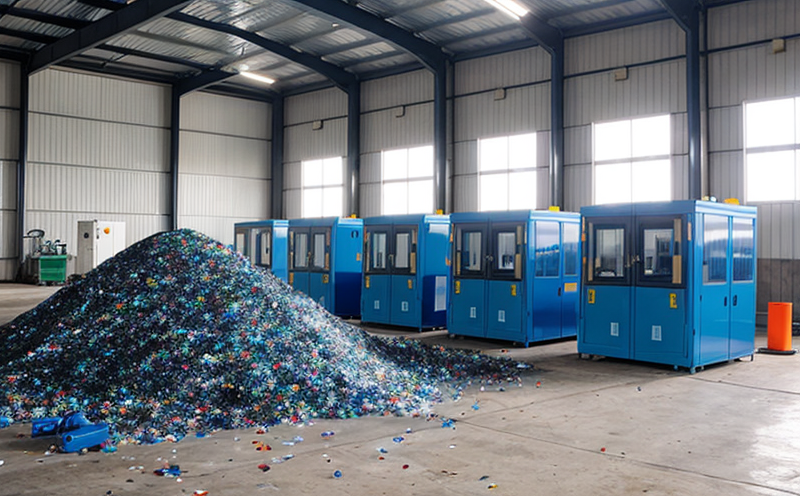ASTM D7850 Flame Retardant Content in Recycled Plastics
The ASTM D7850 test method is specifically designed to determine the flame retardant content and its distribution within recycled plastics. This procedure involves heating a sample of recycled plastic material under controlled conditions, followed by analysis of the volatilized substances using gas chromatography-mass spectrometry (GC-MS). The primary goal is to ensure that recycled materials comply with regulatory requirements regarding flame retardants.
This testing method plays an essential role in quality assurance for manufacturers and suppliers involved in recycling processes. It helps identify any residual or added flame retardant compounds, which can impact the performance of finished products. Flame retardants are often used to enhance fire safety properties but may also pose environmental risks if not properly managed.
The ASTM D7850 test is particularly relevant for sectors such as automotive, electronics, and construction where high-performance materials are crucial yet must meet stringent sustainability goals. By accurately measuring flame retardant content, this procedure supports lifecycle management practices aimed at reducing waste and promoting resource efficiency.
In the context of recycling, understanding the presence and distribution of flame retardants is critical for several reasons:
- It ensures product safety by preventing hazardous emissions during processing or use.
- It supports regulatory compliance with international standards like ISO 17456-3:2019.
- It enhances the reliability of recycled materials, ensuring consistent performance across batches.
The testing process typically involves several key steps:
- Sampling: Representative samples are taken from the batch of recycled plastic.
- Precipitation: The sample is dissolved in an appropriate solvent and precipitated to remove non-flame retardant components.
- Vaporization: The precipitate is heated at a specific temperature over time, allowing flame retardants to volatilize.
- Analysis: Volatile compounds are captured and analyzed using GC-MS for identification and quantification.
The results provide detailed information on the types and concentrations of flame retardants present in the sample. This data is invaluable for process optimization, raw material selection, and product development.
A thorough understanding of the test procedure and its implications is crucial for stakeholders involved in waste management and recycling initiatives. Proper execution ensures accurate representation of recycled plastic characteristics, contributing to more sustainable practices throughout industries reliant on these materials.
Why Choose This Test
- Comprehensive analysis of flame retardant content in recycled plastics.
- Supports compliance with international standards such as ASTM D7850 and ISO 17456-3:2019.
- Promotes safer production processes by minimizing hazardous emissions during recycling.
- Enhances the quality of recycled materials, ensuring consistent performance across batches.
- Aids in material selection and process optimization for manufacturers and suppliers.
- Provides valuable insights into flame retardant distribution within recycled plastics.
The ASTM D7850 test is indispensable for quality assurance teams, compliance officers, R&D engineers, and procurement professionals working with recycled materials. It ensures that products meet safety standards while promoting sustainable practices in waste management and recycling.
Environmental and Sustainability Contributions
The ASTM D7850 flame retardant content test contributes significantly to environmental sustainability efforts by addressing key issues related to recycled plastics. By accurately measuring the presence of flame retardants, this procedure helps mitigate potential risks associated with these compounds:
- Reduction in hazardous emissions: Ensures that fire safety additives do not release harmful substances during processing or use.
- Sustainable resource management: Promotes efficient use of recycled materials without compromising product quality.
- Eco-friendly production processes: Supports the development of safer, more environmentally friendly recycling technologies.
This testing method aligns with broader sustainability goals by fostering innovation in waste management and recycling. It encourages the creation of closed-loop systems where recycled plastics can be reintroduced into manufacturing without degrading product performance or compromising safety standards.
By integrating ASTM D7850 compliance into their operations, organizations contribute positively to environmental conservation efforts. They demonstrate a commitment to responsible stewardship of resources and promote safer, more sustainable practices across industries.
Competitive Advantage and Market Impact
The ASTM D7850 flame retardant content test offers significant competitive advantages for businesses operating in the waste management and recycling sectors. Compliance with this standard enhances product safety, ensuring that recycled plastics meet stringent fire safety requirements without compromising performance:
- Enhanced market credibility: Demonstrates a commitment to quality and regulatory compliance.
- Increased customer trust: Builds confidence among consumers who prioritize environmentally friendly products.
- Promotes innovation: Encourages the development of safer, more sustainable recycling technologies.
- Sustained competitive edge: Ensures long-term viability by meeting evolving regulatory standards and market demands.
In a rapidly evolving industry landscape characterized by increasing pressure to adopt eco-friendly practices, organizations that prioritize ASTM D7850 compliance gain a strategic advantage. They position themselves as leaders in sustainable manufacturing and waste management, attracting environmentally conscious customers and stakeholders.
The test also plays a crucial role in fostering innovation within the recycling sector by providing valuable data on flame retardant distribution within recycled plastics. This information supports R&D efforts aimed at creating safer, more durable products while minimizing environmental impact.





